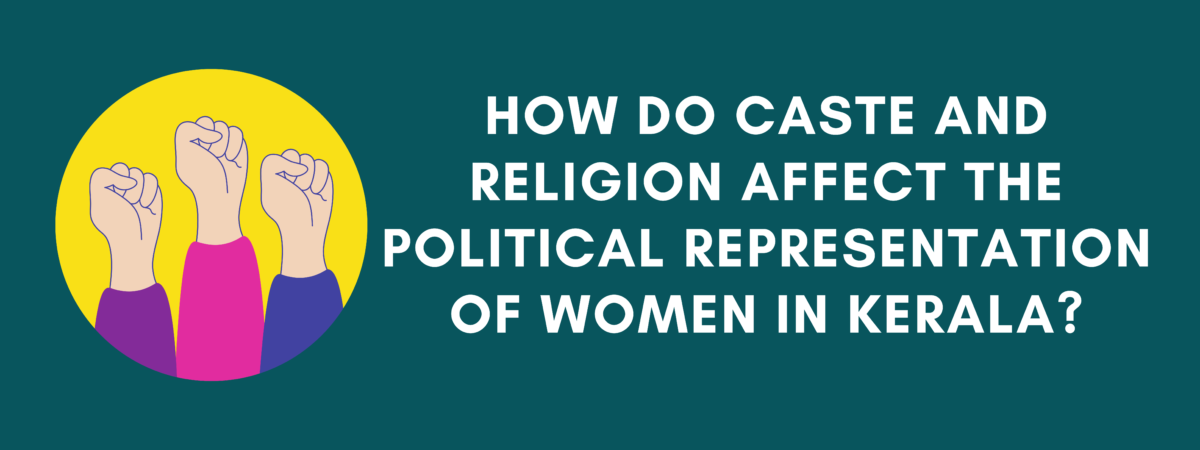Shreya Shreya
18 May 2021 | 2 min read
The female representation in the Kerala State Legislative Assembly has been between 5%-6%, over the past years (2001-2016) according to an article – Is Kerala really inclusive? 33 charts about MLAs in new assembly show there’s still work to be done, published in Scroll. This number rose to 8% in the 2021 state elections, however, it is lower compared to the 11% female candidacy in the election. What is worth wondering is what do these numbers represent at their core in different contexts? In this article, there is a breakdown of women’s participation in Kerala’s political scene based on the dynamics of caste and religion, thereby understanding the diversity among female politicians and the reasons that characterize this diversity.
Percentage of female candidacy against female MLAs in Kerala during last 4 elections
Source: TCPD-SPINPER Indian Legislator Dataset
| Year | Female Candidates (percentage) | Female Elected Representatives (percentage) |
| 2006 | 7.5% | 5% |
| 2011 | 8.5% | 5% |
| 2016 | 9.1% | 5.7% |
| 2021 | 11% | 7.9% |
The total number of women who contested elections and won in Kerala in 2021 is low against that of the male candidates, as per the Scroll article referred to earlier in this article. Around 73% of those women belong to either scheduled caste, scheduled tribe, or other backward castes. The majority of women involved in politics coming from the lower castes can be tied up to the idea that social movements and struggles in the past have paved the way for the active involvement of women in the political arena today. Verification for this claim exists in literature which highlights that this has been historically true. A 1991 journal article, Caste, Class and Political Organisation of Women in Kerala by Meera Velayudhan highlights the Ezhava social reforms movement in Kerala and the crucial role of women in it, emerging through the various bodies that were established as a part of the movement. One such body was SNDP Yogam, in a meeting of which in 1925, Gandhi addressed the women and highlighted them as important actors on the path of India’s economic salvation by spinning Khadi. Interestingly, 20% of the women candidates in the 2021 elections belong to the Ezhava community.
Another reason that could explain the active participation of women from lower castes can be reservations. The proportion of female participation in local self-governance in Kerala is much higher than that of the legislative assembly as there is a 50% reservation for women belonging to scheduled castes and tribes in local self-governments (gram panchayats and municipalities).
The religion of the women participating in the election of councilors in Kerala has reflected a peculiar pattern. The highest share has been that of Hinduism (approximately 67.35%), followed by Christianity (19.28%) and then Islam (13%). This result has been highlighted in a 2000 journal article, Political Participation of Women: The Case of Women Councilors in Kerala, India. A similar pattern has can also be observed in the 2021 Kerala state elections wherein, majority of the female candidates contesting the 2021 elections were Hindus, while the percentage of Muslim and Christian female candidates was the same (around 10%). Historically, the number of Muslim women contesting elections in Kerala was the lowest among the three religions and disproportionate to the share of the population of Muslim women in the state by about 10%. What is surprising is that IUML fielded the first woman candidate in 25 years in 2021 by nominating Noorbina Rashid after their woman candidate, Elamaram Kareem was defeated in the 1996 elections. However, she did not register a win.
Looking at the dynamics of caste and religion among the male candidates on the other hand shows that the proportion of the male candidates belonging to the lower castes in 2021 elections was 23%, much lower than what exists for the women of the state (73%), while on the other hand, the composition sprouting from within the religious groups is the same- Hindu candidates are the highest in number (25%), followed by Muslims and Christians with the same proportion (7.2% and 7.34% respectively).
Caste and religion do have some distinctive roles to play not only among the female candidates but also relative to the male candidates. The reasons explaining the representation in political participation in Kerala can be several such as social movements and struggles of the past have paved the way for women’s involvement in politics, reservation for female candidates in local self-governments, and the composition of the population based on religion and nature and history related to those religions. Further research is required to explore the role of each.
Acknowledgements: We thank Avishek Jha for editing and feedback.
We encourage you to explore the data and use the incumbency tool. It is the product of a lot of time, hard work and love put in by TCPD staff members and our fabulous interns. If you spot errors and/or have any feedback, please get in touch with us at tcpd-contact@ashoka.edu.in
References
The SPINPER Project – The Social Profile of the Indian National and Provincial Elected Representatives. http://liaspinper.com/. Forthcoming
Verniers, Gilles, Basim-u-Nissa, Mohit Kumar and Neelesh Agrawal. “Is Kerala really inclusive? 33 charts about MLAs in new assembly show there’s still work to be done”. Scroll.in
Sooryarmoorthy, R., and D. Renjini. “Political Participation of Women: The Case of Women Councilors in Kerala, India.” Journal of Third World Studies 17, no. 1 (2000): 45-60. http://www.jstor.org/stable/45197846.

